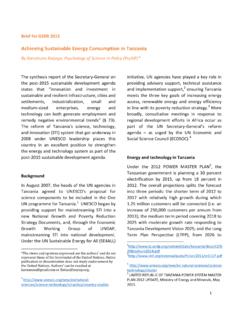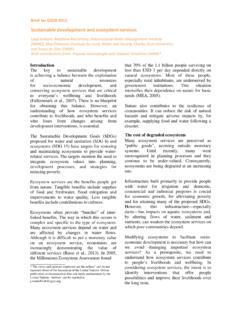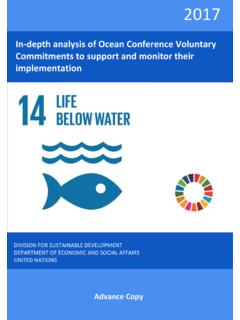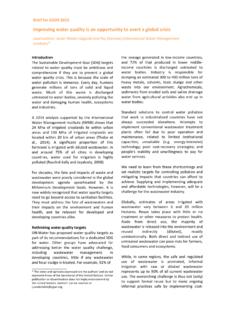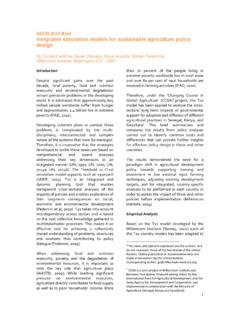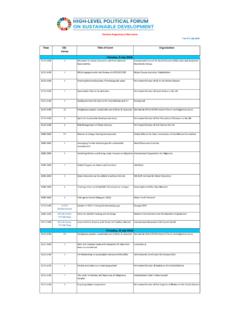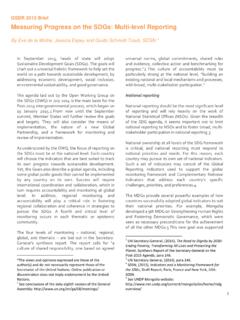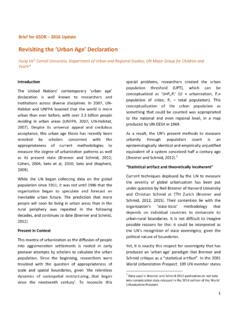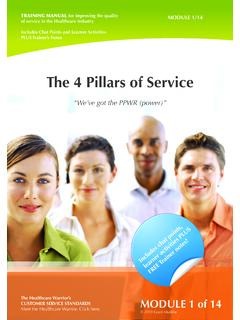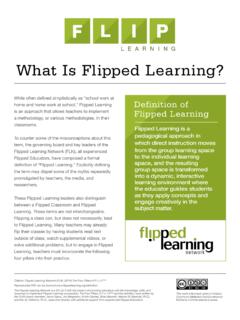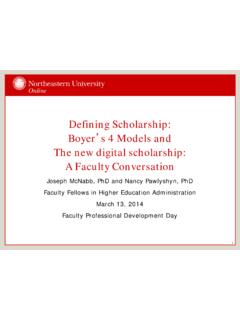Transcription of Balancing the pillars: Eradicating poverty, protecting the ...
1 1 Balancing the pillars : Eradicating poverty , protecting the planet and promoting shared prosperity Together 2030 Written Inputs to the UN High-Level Political Forum (HLPF) 2017 April 2017 Summary: At the HLPF 2017, governments should clearly report on how they are implementing their integrated promises and commitments; mainstreaming the SDGs into their national plans and budgets and working towards Eradicating poverty and hunger everywhere, realizing human rights, ensuring fair and sustainable management of natural resources and ecosystems, and combating inequalities well before 2030. Furthermore, governments must share how they are generating effective and inclusive institutions for SDG delivery. At the HLPF, members states should focus on four main themes: 1) poverty eradication that leaves no one behind; 2) Prosperity shared in a people-centered economy; 3) A planet that is protected; and (4) Institutions at all levels that are participatory, transparent and accountable.
2 Approaches to poverty alleviation shared at the HLPF must include concrete budgeted policies that promote women s rights and gender equality, children s rights, overcoming barriers for the inclusion of persons with disabilities, migrants, minority ethnic groups, young and older persons and others. The HLPF needs to proactively build on existing mechanisms and functional bodies to deliver on its mandate of policy coherence, particularly on thematic issues. The HLPF is an opportunity to (i) assess gaps in existing mechanisms and identify which population groups are not properly reviewed vis-a-vis SDG progress and (ii) define proper mechanisms to overcome such gaps. With regards to the Voluntary National Reviews, we expect presentations to clearly: (i) outline how inclusive the national process has been at country level; (ii) address comprehensive, coherent implementation of the 2030 Agenda and (iii) explain how the accountability framework surrounding VNRs will be progressively strengthened.
3 Preparatory events around thematic reviews should be supported and rest on contributions by all stakeholders. VNR countries should state when they plan to volunteer again and an accountability cycle should be continually in place until 2030, providing regular and predictable spaces for interaction, review and participation. Governments should report on the creation of clear, open, coherent, transparent and regular spaces for the participation of stakeholders in the planning, implementation and accountability of the 2030 Agenda at all levels. Any country that leaves the most marginalized, vulnerable and disadvantaged outside the door of their national discussions cannot be said to leave no one behind . So far, civil society experiences of participation vary and, in several countries, efforts to include civil society still appear to be tokenistic or there is still a perception that government officials are uncomfortable with building working relationships with civil society.
4 Funding continues to be a major barrier for the participation of civil society together with lack of capacity to understand the Goals and their interlinkages. Efforts should also be undertaken at all levels to engage stakeholders beyond the usual suspects and consultation has to be cross-sectoral and country-wide, not restricted to capitals and other centers of power. 2 In some developed countries, it has been a challenge to engage domestic stakeholders beyond environmental and development-focused NGO. Engaging subnational government bodies is still a challenge, due to unawareness or the perception of the SDGs as an external agenda . Paragraph 89 of the 2030 Agenda calls on major groups and other relevant stakeholders to report on their contribution to the implementation of the Agenda and this is still a missing piece of the global follow up and review architecture. UN Member States and the President of ECOSOC should establish clear and meaningful mechanisms beyond online platforms - to collect, publicize and analyze reports on the contribution of civil society and stakeholders to the implementation of the 2030 Agenda at all levels.
5 Finally, the HLPF ministerial declaration should encourage governments to partner with civil society and stakeholders in developing capacity building and awareness programs on the 2030 Agenda. Comprehensive contribution: I Balancing the pillars of sustainable development The High Level Political Forum (HLPF) s theme this year " Eradicating poverty and promoting prosperity in a changing world" is an invitation for attending Governments to reinforce the political will on the ground to reflect, within national contexts, the global support of the Sustainable Development Goals (SDGs) demonstrated in 2015. Governments should present plans and policies on poverty alleviation and eradication and on all the goals, as well as the interlinkages among the goals that are part of the thematic focus for this year s HLPF. It is therefore time for governments to clearly report on how they are implementing their integrated promises and commitments; mainstreaming the SDGs into their national plans and budgets and working towards Eradicating poverty and hunger everywhere, realizing human rights, ensuring fair and sustainable management of natural resources and ecosystems, as well as combating inequalities well before 2030.
6 Furthermore, governments must share how they are generating effective and inclusive institutions for SDG delivery what can be considered the fourth pillar of sustainable development. These institutions must themselves also leave no one behind . It has been reaffirmed time and time again that poverty will only be eradicated if prosperity is equitably shared, social protection is a reality and if the planet is protected. Integrating and Balancing the three pillars of sustainable development (social, environmental and economic) lies at the core of the 2030 Agenda for Sustainable Development and is a key element of the HLPF discussions. (1) poverty eradication that leaves no one behind Developing countries have experienced advances in the past decades. Hundreds of millions of people have been lifted out of poverty and some billion escaped extreme poverty . However, billion adults live in multidimensional poverty and one in nine people still go to bed hungry, even as studies show that 3 three-quarters of extreme poverty could be eliminated now, through better, progressive taxation whilst cutting down on military and other regressive spending1.
7 poverty eradication demands tailored approaches that equally address the multidimensional aspects of poverty and the need to reduce inequalities within societies. Children, especially girls, are disproportionately affected by poverty and even more so by extreme poverty . Falling into poverty in childhood can last a lifetime; there are no second chances for a healthy start in life or to access education. Approaches to poverty alleviation, then, must include concrete budgeted policies that promote women s rights and gender equality, children s rights, overcoming barriers for the inclusion of persons with disabilities, migrants, minority ethnic groups, young and older persons and others. Strong investment in quality education for all ages is an essential element for sustainable development and the eradication of poverty . Furthermore, governments must take appropriate measures to ensure accessibility in the physical environment, to transportation, to information and communications, both in urban and in rural areas, to allow for the inclusion of persons with disabilities.
8 (2) Prosperity shared in a people-centered economy The type of prosperity to be promoted is the one that can be shared and benefit the whole society and not only the richest, as is the current trend. The private sector should be a responsible partner in the promotion of sustainable development and businesses, at the heart of a market yet people-centered economy and should work for the benefit of the whole society in order to allow prosperity to become a reality beyond shareholders. Instead, public-private partnerships (PPPs) present pitfalls that are leaving people behind due to lack of transparency and accountability and governments failing or lacking capacity to monitor the PPPs. PPPs should therefore be implemented in line with country-driven priorities with appropriate risk management and regulatory frameworks. Measures to regulate the private sector and alternative approaches such as the Social and Solidarity Economy, development of cooperatives and social enterprises will be essential to achieve the SDGs.
9 (3) A planet that is protected The economic pillar of sustainable development should be promoted in an integrated approach that includes Sustainable Consumption and Production (SCP), as stated on Goal 12. protecting nature and ensuring equitable access to environmental resources also supports vulnerable and marginalized groups continued enjoyment of their rights to life, health, food and water. Moreover, the impacts of climate change on poverty eradication, hunger and sustainable development are clear and those linkages must be brought to the HLPF discussions. The HLPF brings an opportunity for governments to share ideas on which broader measures of progress (beyond GDP) are being established (para 48) and how economic growth is being decoupled from resource consumption and environmental degradation (Target ). This 1 4 will be critical for a revitalized analysis of the multiple dimensions of poverty and of how prosperity is not only being promoted but also shared.
10 (4) Institutions at all levels that are participatory, transparent and accountable Governments truly accountable to each of their citizens, including the most vulnerable and marginalized those they pledged not to leave behind are critical if all this is to happen. Enabling civic spaces generate opportunities for the poorest and most vulnerable, particularly women, children, youth and older persons, persons with disabilities and others to engage in decisions that affect their own lives, expressing challenges and devising solutions and strategies. The left behind need to be known and made statistically visible as a valuable resource at the global, national, and subnational scales. Civil society groups have demonstrated their impact through the sector s high degree of responsiveness and flexibility to changing political and social landscapes, their ability to stimulate action through public engagement, and their ability to provide a voice to a collective set of values that is deeply rooted in communities, but still scalable to partnerships and networks.

